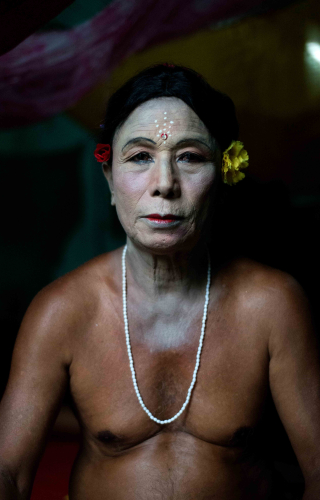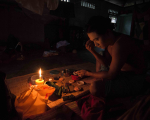The amaibis, and their counterpart, the amaibas, are the priestesses and priests respectively of the Sanamahi religion of the Meitei (alternately Meetei or Meithei) people of Manipur. Unlike the amaibas, who are male, the position of amaibis are not determined by gender. The amaibis comprise both nupa (male) and nupi (female) identities.
Origin
There is also the difference between how nupa amaibis and nupi amaibis trace their origin to different epochs in the origin myth of the Meiteis. The nupa amaibis trace their origin to Atingkok Mapu Sidaba (the Supreme God) who, at the time of creation, gave a tarang mapao (message of the God), ushering the dawn of the universe. This tarang mapao, according to the nupa amaibis, makes the Atingkok Mapu Sidaba, the first nupa amaibi.
According to Numit Kappa, the ancient epic of the Meiteis, nupi amaibi priestesses as we know now came much later, when after the creation of the universe, we reached a time when there were two suns in the sky. In this mythological story, Goddess Panthoibi was the first to take the form of a nupi amaibi.
Earlier, when Manipur was a kingdom, the nupa amaibis were patronised by the royal family, and they would conduct the coronation ceremony of kings which involved strict rituals. Even now, the amaibis are expected to be thoroughly trained in performing rituals for the various deities in the Sanamahi religion. They act as a bridge between the lais (generic term for deities in Manipur) and the devotees, especially during the Lai Haraoba (merrymaking of gods) festival of the Meiteis. Amaibis predict future events, interpret dreams, warn the Meiteis of dangers and also suggest remedial measures.
Much venerated for their knowledge and special powers, amaibis hold an exalted position in traditional Meitei society and they present a curious case of gender fluidity in the Manipuri cultural context. ‘Nupa’ means male while ‘amaibi’ is a feminine term which shows a certain gender nonconformity in the name itself. They trace this ambiguity in the concept of ‘pa’ and ‘pi’. According to this philosophy, the world of the living beings is the world of two: the pa (as in amaiba, with ‘ba’ being the later evolution of the ‘pa’) and pi (as in amaibi, with the ‘bi’ sound being the later evolution of the sound ‘pi’). The Lord of the Universe, with their hair lock in front is the Supreme Pa, Lainingthou (king of gods, identified as a masculine entity), and with their hair lock at the back is the Supreme Pi, Lairembi (supreme female deity). The one Supreme Being can thus be worshipped as Lainingthou or Lairembi or both together. This gender fluidity is exemplified in the nupa amaibi. According to the nupa amaibi themselves, they look like a man from the front and like a woman from the back, and when someone call them ‘epa’ (father) they reply ‘hao’ (affirmative response) and when they are called ‘ema’ (mother), again, they reply ‘hao’.
Initiation and Training
No one can choose to become an amaibi. A woman may become a nupi amaibi either after being chosen by the Lai at the Lai Haraoba or being directly possessed by the Lai. There is no restriction of age in becoming an amaibi; once possessed, an amaibi may blabber incoherently, perspire, tremble violently, refuse food and run relentlessly in a wild manner. A potential amaibi is thus identified and she is initiated through her ema guru. The ema guru teaches the novice sacred texts of the Puya (the religious texts of Sanamahism). She is also trained in dance, singing, music and performance of complex rituals. After the novice completes her training under her ema guru, she is asked to appear before the pandit loishang (council of priests). The pandit lioshang performs the kandha epan thaba rite which purifies the novice, and thereafter, she becomes a full-fledged amaibi and can practice on her own. The pandit loishang designates the amaibis with their specific tasks during the Lai Haraoba, which takes place in several places in Manipur (Kanglei Haraoba, Chakpa Haraoba, Andro Haraoba, Sekmai Haraoba, Moirang Haraoba and Kakching Haraoba) with regional variations.
The Tradition at Present
Because of their mysterious personal connection with the umang lai (forest deities), the amaibis are revered and command respect, and no one would dare to pique their wrath. However, in the present time, a general degradation of practices has set in among the younger amaibi practitioners. This is as much to do with the religious shamans as with the common people, who have started disregarding their ancestors' way of life and have adopted modern life. Many of the nupa amaibis themselves have started giving up their priesthood, citing lack of economic opportunity and prestige in today’s society. Some of the older amaibis work as potloi setpa (makeup artist), assisting Manipuri Hindu brides in preparation for their wedding by putting on makeup and the elaborate potloi costume. Some have found employment at Jawaharlal Nehru Manipur Dance Academy, in Imphal, where they teach about the amaibi practices. Some of the younger amaibis work in beauty salons, a profession which is much derided by the older generation. Add to that the general discomfort people have towards people of gender nonconformity and we have a situation where the nupa amaibi, as a social institution, is declining with just a few dozens still practicing the way of life.
*
I would like to thank Ema Thoibi, a very senior nupi (female) amaibi of pandit loishang, for the information she provided. She currently holds sanglakpi (the second highest post) in the amaibi branch of the pandit loishang (this includes both nupa and nupi amaibi).
Bibliography
1. “The Religion of Manipur” by Saroj Nalini Arambam Parratt
2. “The Pleasing of the Gods - Meitei Lai Haraoba” by Saroj N Arambam Parratt and John Parratt
3. “Ritual, Politics and Power in North East India: Contextualising the Lai Haraoba of Manipur” by Otojit Kshtrimayum
4. “Cheitharon Kumpapa: The Court Chronicle of the Kings of Manipur” by Saroj Nalini Arambam Parratt
5. “Manipur: Past and Present - Volume 2” edited by Naorem Sanajaoba
6. “Early Meitei History: Religion, Society and the Manipuri Puyas” by Rena Laisram

















